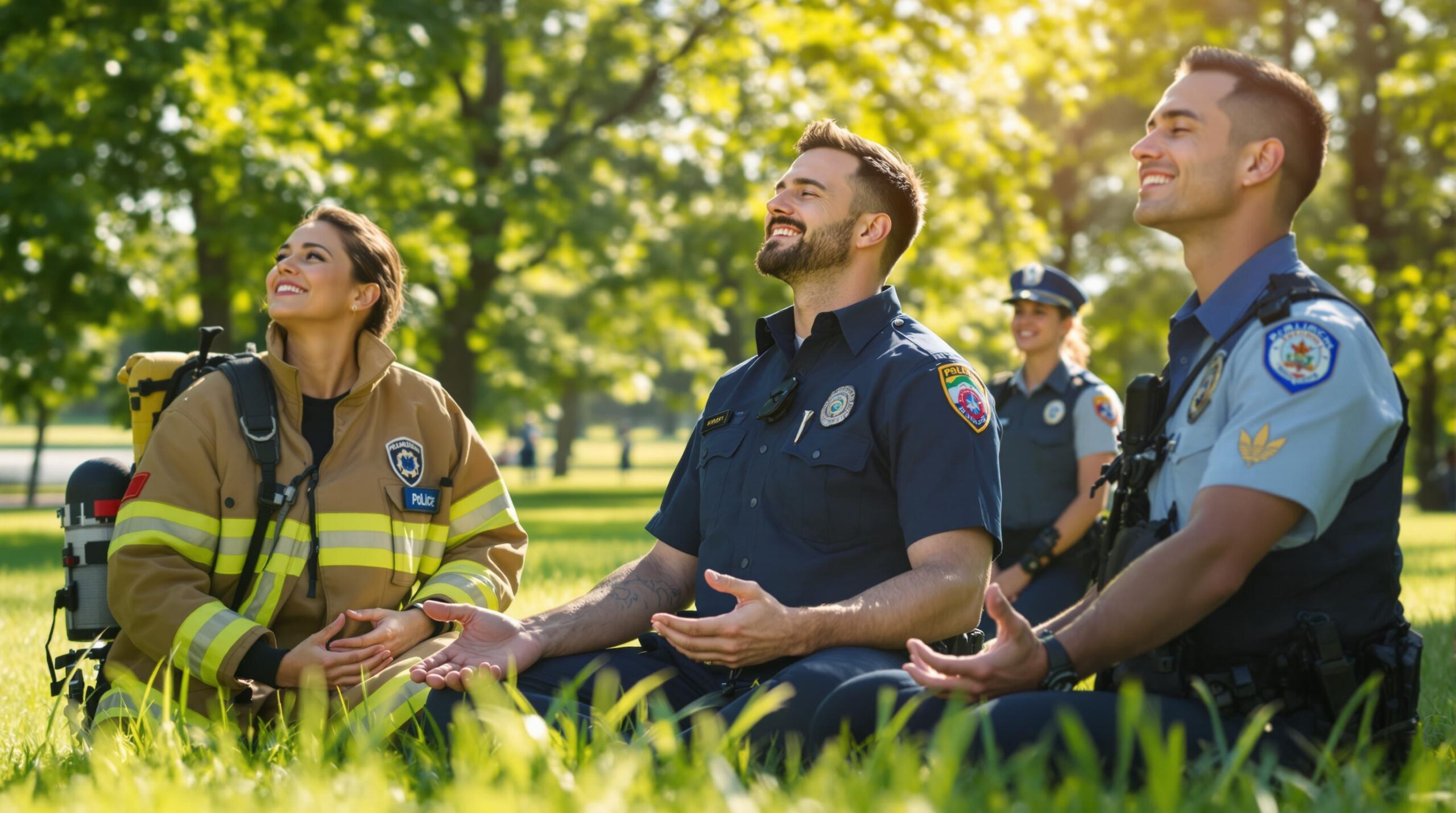Did you know that suicide rates among first responders often surpass on-duty fatalities? The mental challenges faced by law enforcement officers, firefighters, and other emergency workers are immense. Building mental resilience is not just about handling stress – it’s about improving job performance, protecting long-term health, and ensuring a better quality of life during and after service.
Here’s a quick summary of actionable steps to strengthen mental resilience:
- Practice Mindfulness: Use simple techniques like tactical breathing or the 3-3-3 grounding method to manage stress in real time.
- Build Peer Support Networks: Connect with colleagues through post-incident check-ins and shared activities to foster trust and emotional support.
- Leverage Technology: Tools like SWORN.ai offer real-time stress tracking and personalized wellness strategies for first responders.
- Seek Professional Help: Resources such as Safe Call Now and CopLine provide confidential crisis support and counseling.
Mental resilience is a skill you can develop. By combining mindfulness, strong social connections, and modern tools, you can better handle the pressures of your role while protecting your mental health. Let’s dive into how you can start today.
Mental Resilience Basics for First Responders
Defining Mental Resilience
Mental resilience refers to the ability to maintain consistent performance during traumatic events, unexpected challenges, or high-pressure situations. Experts describe it as a mental buffer that helps individuals recover and continue functioning effectively. Studies confirm that resilience is a skill that can be developed as a positive response to stress. Let’s take a closer look at the daily stressors first responders face.
Common Stress Factors
First responders deal with stressors that are unique to their roles, often leading to what researchers call compound stress. Here’s a breakdown of the main stress categories and their effects:
| Stress Category | Common Examples | Impact Level |
|---|---|---|
| Operational | Trauma exposure, life-threatening situations, critical incidents | High |
| Organizational | Staff shortages, shift work, inconsistent leadership | Medium-High |
| Physical | Sleep disorders (affecting 40% of officers), irregular meals | Medium |
| Social | Public scrutiny, media pressure, family strain | Medium-High |
These challenges highlight the complex pressures first responders face, which directly influence their mental and physical performance.
Impact on Job Performance
The stressors above don’t just affect mental health – they also interfere with job performance. Dr. Todd Brimm explains the gravity of these effects:
"The psychological and emotional effects that are often the products of a career in law enforcement can be severe. And in many instances officers and retired officers lose the battles for their minds and spirits."
Poor mental resilience can show up in several ways:
- Increased citizen complaints
- Reduced situational awareness
- Impaired decision-making
- Weak team communication
The long-term effects are even more alarming. Research indicates that officers often face a shorter life expectancy after retirement, with many living only two to five years post-service. Strengthening mental resilience early in their careers can help reduce these risks and improve both performance and well-being.
Daily Mindfulness Methods
Mindfulness Results for First Responders
First responders often face intense stress, with up to 85% reporting mental health challenges. Depression and PTSD rates among them are about five times higher than in the general population. Introducing mindfulness into daily routines can help them stay mentally sharp and emotionally steady. Many first responders notice that mindfulness boosts their ability to manage stress, stay focused, and handle emotions effectively during high-pressure situations. These practices align well with the resilience strategies discussed earlier.
Quick Mindfulness Exercises
Here are a few easy techniques to add mindfulness to even the busiest shifts:
-
The 3-3-3 Grounding Technique
Identify three things you can see, three sounds you can hear, and three physical sensations you can feel. This quick exercise helps reset your stress response in under a minute. -
Tactical Breathing
During equipment checks or between calls, try tactical breathing: inhale, hold, exhale, and pause for four counts each. This method helps regulate your heart rate and keeps you focused. -
Micro-Meditation Moments
Use short pauses, like waiting for dispatch or during meal breaks, to do a 30-second mindfulness check. Focus on your breathing and physical sensations to recenter yourself.
Tools and Resources
Modern tools make mindfulness easier to fit into a first responder’s demanding schedule. For example, SWORN.ai’s platform uses real-time biometric tracking and personalized wellness strategies to suggest the best times for mindfulness exercises. Key features include:
- Real-time biometric tracking
- Tailored prompts for breathing exercises
- Progress tracking and performance insights
The platform’s AI-driven system analyzes stress patterns and offers personalized mindfulness suggestions, helping first responders seamlessly integrate these practices into their routines.
"Empowering Those Who Serve with Resilience & Support." – SWORN.ai
Building Support Systems
Working with Peers
Strong connections among peers play a key role in improving resilience for first responders. Research shows that 91.6% of first responders find peer support helpful, with a 20% reduction in perceived challenges when such support is present. These stats highlight the value of fostering meaningful relationships with colleagues.
Here are a couple of ways to strengthen peer support:
- Post-Incident Check-ins: After incidents, check in with your teammates. Studies reveal that proactive support, including from supervisors, can significantly improve team resilience.
- Shared Activities: Simple activities like working out together or sharing meals can naturally build trust and camaraderie.
These practices create a solid foundation for stronger team dynamics.
Team Connection Strategies
Creating a supportive team environment requires deliberate effort. Peer support programs often see better participation rates than traditional Employee Assistance Programs (EAPs). Effective strategies include:
- Choosing facilitators through nominations
- Providing training in active listening and managing stress
- Practicing skills through regular role-play scenarios
- Establishing clear rules around confidentiality
The impact of these programs is evident: nearly half (48.3%) of police officers reported improvements in both job performance and home life due to peer support.
When peer and team-based support isn’t enough, seeking professional help becomes essential.
Professional Help Options
Knowing when to seek professional assistance is critical for maintaining resilience in high-stress roles. Be on the lookout for early warning signs such as:
- Difficulty sleeping
- Mood swings
- Trouble focusing
- Feelings of isolation
First responders have access to a variety of specialized resources:
| Resource Type | Services Offered | Access Method |
|---|---|---|
| Safe Call Now | 24/7 Crisis Support | Confidential Hotline |
| Next Rung | Peer Counseling | Online Platform |
| HERO | Trauma-Informed Care | In-Person/Virtual |
| CopLine | Anonymous Support | Phone/Text Service |
Taking action early – whether through time off, hobbies, or spending quality time with family – can help reduce burnout risks. Building strong social connections also helps counteract the effects of long-term stress.
sbb-itb-aa48905
Building Resiliency in First Responders – A Complete Approach
Stress Management Methods
Effectively handling stress is essential for first responders who face high-pressure situations every day. These methods work alongside mindfulness practices to build resilience and maintain focus.
Quick Stress Relief Techniques
Combat breathing, also known as tactical breathing, offers fast stress relief during intense moments. This technique helps calm the body by activating the parasympathetic nervous system:
- Inhale through your nose for 4 counts
- Hold your breath for 4 counts
- Exhale through your mouth for 4 counts
- Hold your breath again for 4 counts
"Combat breathing can help someone who is experiencing peak levels of stress rapidly regain control of their mind and body." – Angeleic Huth, Law Enforcement/Police Science Teacher
Repeat this cycle 8–10 times. Research shows that 90% of first responders experience noticeable stress reduction when using mindfulness techniques during their work shifts. Beyond addressing immediate stress, maintaining this practice throughout the day helps build long-term resilience.
Thought Management Skills
In addition to tactical breathing, thought management techniques can help regulate stress consistently during different parts of your shift. These strategies can easily fit into your daily routine:
| Time of Day | Technique | Duration | Effect |
|---|---|---|---|
| Start of Shift | Mindful Breathing | 5 minutes | Creates a calm, focused mindset |
| During Calls | Rapid Reset Breathing | 1–2 minutes | Provides quick stress relief |
| Break Time | Body Scan | 10 minutes | Eases physical tension |
| End of Shift | Mindful Journaling | 15 minutes | Processes the day’s experiences |
Before tackling a particularly demanding situation, try the following steps:
- Visualize yourself staying calm under pressure
- Concentrate on steady, controlled breathing
- Imagine positive outcomes
- Remind yourself of your training and skills
Practicing these techniques regularly can improve emotional control and boost job performance.
Tech Tools for Mental Health
Modern technology is transforming mental health support for first responders, offering digital tools that complement traditional methods. These tools provide real-time support and monitoring, enhancing overall wellness practices.
AI Mental Health Support
SWORN.ai uses biometric data and workload analytics to deliver tailored mental health assistance. Here’s how it works:
| Feature | Purpose | Outcome |
|---|---|---|
| Biometric Tracking | Monitors stress in real time | Enables early intervention |
| Workload Analysis | Offers personalized guidance | Promotes better work-life balance |
| Evidence-Based Tools | Provides proven wellness strategies | Strengthens resilience |
"SWORN harnesses cutting-edge AI to blend real-time biometric insights, workload analytics, and evidence-based wellness strategies with personalized family, peer, and professional support – empowering first responders to elevate their health, performance, and resilience."
Stress Monitoring Systems
Digital stress monitoring helps first responders identify stress triggers before they escalate. With 85% of first responders experiencing mental health symptoms, tracking these metrics is crucial:
- Heart rate variability
- Sleep quality and patterns
- Physical activity levels
- Stress responses
- Recovery times
This data provides a detailed view of mental and physical health, allowing for proactive stress management. Alongside these systems, digital training programs offer flexible and personalized mental health education.
Digital Training Programs
Virtual platforms provide private, on-demand access to mental health resources. These programs are especially vital, as first responders face depression and PTSD rates five times higher than the general population.
Key features of effective digital training include:
1. Personalized Learning Paths
Courses are tailored to fit specific roles, schedules, and stress profiles.
2. Scientifically Backed Tools
Users gain access to proven techniques and exercises for mental well-being.
3. Progress Tracking
Regular assessments help monitor improvements and refine strategies.
These platforms ensure discreet, consistent support. With suicide being a leading cause of death among first responders, timely and accessible intervention can make a life-saving difference.
Conclusion
Studies reveal that 15%–30% of first responders experience PTSD, with suicide rates sometimes surpassing on-duty fatalities.
Building mental strength starts with understanding the specific challenges faced by first responders. Research highlights that resilience isn’t about avoiding stress – it’s about confronting challenges directly and growing through those experiences.
Blending traditional support systems with modern tools can further bolster resilience. Departments that prioritize open conversations and proactive mental health planning often see positive results in several key areas:
| Area of Impact | Positive Outcomes |
|---|---|
| Job Performance | Better decision-making, fewer workplace accidents, and a decrease in excessive force incidents |
| Department Metrics | Lower rates of citizen complaints and reduced organizational risks |
| Personal Well-being | Improved balance between work and personal life, along with stronger family connections |
To start seeing results, try these practical approaches:
- Incorporate physical activity and mindfulness into your daily routine to release stress.
- Connect with peer support networks for emotional encouragement.
- Use digital tools to track and manage stress effectively.
- Practice techniques that help regulate emotions consistently.
Resilience is a process, not a one-time fix. These methods provide a strong starting point for improving mental health, professional performance, and the ability to serve your community with strength and focus.



